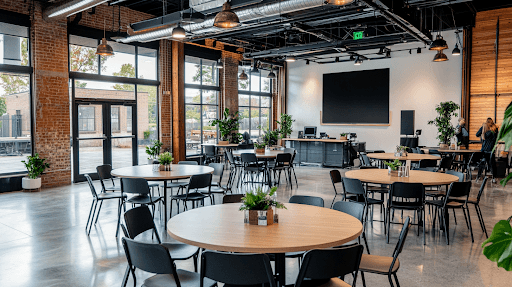Event marketing can quickly get overwhelming without a clear plan. From organizing event details to promoting the event and engaging attendees, there are a lot of moving parts that demand attention.
A small oversight could impact your results in big ways. That’s why having a reliable checklist is important to keep everything on track and stress-free. This article provides a practical event marketing checklist to streamline your planning, execution, and follow-up.
Looking for a complete event marketing resource? Read "Everything You Need to Know About Event Marketing."
What is an Event Marketing Checklist?
An event marketing checklist is a practical tool designed to organize and track every critical task required for a successful event marketing campaign. It functions as a structured roadmap, outlining the sequential steps necessary to execute marketing activities effectively.
By providing a clear framework, it ensures nothing essential is missed during the planning, implementation, or follow-up stages.
This tool also helps maintain organization and structure. It is a central reference point for teams, streamlining processes and reducing the likelihood of errors or overlooked tasks. For example, it can assist in breaking down complex campaigns into manageable actions, assigning specific responsibilities to team members, and tracking progress to ensure deadlines are met.
A checklist is especially valuable in minimizing risks associated with event marketing. It safeguards against common pitfalls like forgetting to confirm vendor arrangements, missing promotional deadlines, or neglecting audience engagement strategies. By systematically addressing these tasks, you can focus on delivering a seamless and impactful event campaign.
Download our free webinar checklist below to ensure you never miss a crucial detail in your event marketing campaigns
1. Planning and Preparation of Event Marketing
Set Marketing Goals
To ensure your event marketing campaign stays on track, establishing clear and measurable goals is important. Your objectives will act as a compass, guiding your strategy and helping you assess success.
The most effective way to structure these goals is by using the SMART framework:
Specific: Define exactly what you want to achieve. For example, instead of setting a vague goal like "increase attendance," specify a target such as "attract 200 first-time attendees."
Measurable: Use metrics to track progress. Goals like "boost ticket sales by 25%" or "generate 150 qualified leads" provide clear benchmarks for success.
Achievable: Ensure your goals are realistic given your resources, timeline, and audience size. Over-ambitious objectives can derail planning and execution.
Relevant: Align your event goals with overarching business objectives. For example, if your organization prioritizes brand awareness, a relevant goal could be to "increase social media mentions by 40% during the event."
Time-bound: Set a deadline to create urgency. Whether it's completing registrations by a specific date or achieving sponsorship targets a month before the event, time constraints keep your team focused.
Identify Target Audience
Understanding your target audience is an important step in tailoring your event marketing strategy. It allows you to craft messaging and experiences that resonate deeply with attendees, driving engagement and attendance.
To achieve this, you need to prioritize gathering insights into your audience’s demographics, behaviors, and challenges.
Demographics: Identify key factors such as age, gender, location, and profession. These details help you segment your audience and choose appropriate communication channels.
Behaviors: Study how your audience interacts with similar events or content. Are they likely to engage with digital campaigns, prefer early registration discounts, or respond to influencer recommendations? Understanding these preferences ensures you allocate resources effectively and deliver marketing efforts that align with their habits.
Challenges: Address the pain points your audience faces. This could include a lack of time, limited budgets, or specific knowledge gaps. By offering solutions through your event—such as convenient scheduling, discounted tickets, or valuable educational content—you position the event as a meaningful opportunity instead of just another obligation.
Download our free guide below to discover a step-by-step process for identifying the ideal participants for your events. This comprehensive guide offers insights into understanding your audience’s demographics, behaviors, and challenges, helping you tailor your event planning and content to create meaningful and engaging experiences.
Develop a Marketing Timeline
Start with a pre-event phase to outline all necessary preparations. This includes setting marketing goals, building your event brand, and launching promotional efforts. Key milestones might involve finalizing the event theme, creating registration forms, and scheduling social media announcements. For larger events, planning 12 months or more in advance is typical, while smaller events might require shorter lead times.
Next, define actions for the during-event phase. Focus on real-time engagement, such as live updates on social media, attendee check-ins, and event-day email reminders. Ensure your team knows their roles to address any issues quickly and maintain smooth operations throughout the event.
Finally, prepare for the post-event phase by scheduling follow-up actions. This might include sending thank-you emails, analyzing campaign metrics, and repurposing event content. A structured post-event plan ensures you maintain momentum and extract long-term value from the event.
Breaking your timeline into these phases with clearly defined milestones simplifies task management, keeps your team aligned, and reduces the risk of missed deadlines.
Plan your event communications effortlessly with our free event communication timeline template. Download it to get a step-by-step guide on what actions to take and when for maximum engagement.
Craft Your Event Theme and Messaging
Creating a compelling event theme and messaging is central to drawing your audience’s attention and ensuring that your event aligns with your brand’s purpose. A well-thought-out theme not only shapes the overall event experience but also communicates its value effectively. To achieve this, you have to ensure that the theme resonates with your target audience while staying true to your brand’s core values.
Began by understanding your audience’s preferences, pain points, and aspirations. This insight allows you to craft a theme that feels relevant and meaningful to them.
Equally important is ensuring that the event theme aligns with your brand’s identity and value proposition. The theme should reinforce your brand story and mission, creating consistency across all event touchpoints—from promotional materials to on-site experiences.
Get inspired with our complete event marketing plan example, designed to guide you through every step of your campaign. Download the template to set clear milestones and craft messages for every communication channel effortlessly.
2. Strategy Building for Event Marketing
Choose Marketing Channels
Selecting the right marketing channels is critical to the success of your event marketing campaign. The platforms you choose will determine how effectively you can reach and engage your target audience while staying aligned with your objectives.
Begin by identifying the channels that resonate most with your target audience. Consider their preferences, behaviors, and communication habits. For example, younger demographics might favor social media platforms like Instagram, while a professional audience might respond better to LinkedIn or email campaigns. This audience-centric approach ensures your efforts are both efficient and impactful.
Evaluate both digital and traditional channels to optimize your reach. Digital channels include social media, email, and search engine advertising, offering precise targeting and real-time analytics.
Traditional channels, such as print media, radio, or direct mail, might still hold value, especially for local or niche audiences. The key is to assess which combination of channels best aligns with your audience’s preferences and event goals.
Plan Content Creation
For event marketing success, it is important to create content that resonates with your audience. The content you develop should align with the event’s objectives while capturing the attention of your target audience.
To achieve this, focus on diverse content formats that cater to different preferences and stages of the campaign.
Videos: Event videos are highly engaging and versatile. Use teaser videos to build excitement before the event, behind-the-scenes clips to humanize your brand, and live streams or highlight reels to amplify real-time engagement. Videos also serve as excellent post-event materials for recaps or promotions of future events.
Blogs: Publish blog posts to educate, inform, or entertain your audience while promoting the event. Topics could include event highlights, speaker profiles, or industry insights related to the event’s theme. Blogs can also improve your SEO performance when optimized with relevant keywords, driving organic traffic to your event page.
Infographics: Infographics simplify complex information and make it visually appealing. You can use them to share event schedules, key statistics, or step-by-step guides, such as how to register or what to expect during the event. Their shareable nature makes them ideal for social media promotion.
By utilizing these content types strategically, you can address various audience touchpoints, improve engagement, and ensure your messaging remains consistent throughout the campaign.
Utilize Social Media Platforms
Social media is essential for amplifying your event's visibility and engaging your audience effectively. To maximize its potential, you need to strategically utilize each platform's unique strengths, tailoring your approach based on audience preferences and content format.
For professional networking and thought-leadership events, platforms like LinkedIn excel. Use this space to share event announcements, promote keynote speakers, and publish thought-provoking content that resonates with a professional audience.
LinkedIn’s group features and targeted ads can help you reach specific industries and job roles.
Instagram offers powerful tools if your event relies on striking visuals or storytelling. Post high-quality images and videos that showcase the event's theme, venue, or behind-the-scenes moments. Utilize Instagram Stories and Reels to create short, engaging updates and encourage user-generated content through event-specific hashtags.
Platforms like Facebook are versatile, allowing you to create event pages, post updates, and foster community interaction. Use Facebook’s advertising features to target specific demographics or geographic areas and share engaging content like polls or videos to maintain momentum.
By aligning your content strategy with each platform's strengths, you can create a cohesive and impactful social media presence that drives visibility and engagement.
Collaborate with Influencers and Partners
Collaborating with influencers and partners can significantly improve the reach and credibility of your event marketing efforts. Strategic partnerships allow you to tap into existing networks, utilizing their established audience base and trust.
By associating with reputable partners, you can position your event as more credible and appealing to potential attendees.
When identifying potential collaborators, focus on those whose values, audience demographics, and industry align with your event goals. For example, partnering with a relevant industry association can bring authority to a professional conference, while collaborating with a local business might help a community event gain traction.
Influencers, especially micro-influencers, can help promote your event to highly engaged audiences, often generating better engagement rates compared to larger influencers with less targeted followings.
To maximize the value of these collaborations, create a mutually beneficial agreement. Offer incentives such as co-branded marketing opportunities, free event tickets, or sponsorship visibility in exchange for their promotional efforts.
Clear communication about expectations, deliverables, and timelines ensures a smooth partnership that contributes to the overall success of your event.
3. Execution of Event Marketing Campaigns
Launch Pre-Event Campaigns
Building excitement before an event is critical to driving early engagement and ensuring strong attendance. Pre-event campaigns are your opportunity to capture attention and generate buzz, laying the foundation for success.
To create anticipation, focus on urgency and exclusivity. Limited-time offers, such as early bird pricing or exclusive perks for first-wave registrants, encourage immediate action. These offers incentivize early sign-ups and signal that the event is in demand.
Additionally, teaser content can build intrigue and keep your audience engaged. Share glimpses of what’s to come—such as speaker announcements, behind-the-scenes clips, or event features—across your marketing channels. This approach keeps your audience curious and eager to learn more.
Use Paid Advertising Effectively
Paid advertising can be a powerful tool for expanding your event’s reach and achieving your marketing goals efficiently. To make the most of your ad budget and ensure your efforts drive meaningful results, it’s important to focus on audience segmentation.
Segmenting your audience allows you to direct your ad spend toward high-potential leads more likely to engage with your event. Using data such as demographics, interests, location, and past behaviors, you can create tailored ads that resonate with each segment.
For instance, targeting local audiences with region-specific messaging or reaching out to past attendees with exclusive offers can significantly increase conversion rates.
Platforms like Facebook Ads and Google Ads provide robust targeting options to help refine your audience and maximize ROI.
Boost Real-Time Engagement
Engaging your audience in real-time during an event is important to creating a memorable experience and fostering meaningful connections. By actively involving attendees, you improve their satisfaction and reinforce their investment in your event.
Use live updates to keep attendees informed and excited. Share key moments, speaker highlights, or schedule changes across your event app, social media channels, or display screens.
This keeps everyone aligned and allows those following remotely to feel included. Real-time updates also encourage attendees to share their experiences, amplifying your event’s reach.
Incorporate interactive tools such as polls, Q&A sessions, or live quizzes. These tools allow attendees to voice their opinions, ask questions, and engage directly with speakers or organizers. Not only do they provide valuable insights for you, but they also make participants feel heard and valued.
Host interactive sessions like breakout groups or networking games. These activities encourage collaboration and deepen connections between attendees. The more personalized and engaging your content, your audience will likely remain attentive and involved throughout the event.
Monitor Campaign Metrics
Monitoring campaign metrics is important to ensure your event marketing efforts are on the right track and delivering the desired outcomes. By paying close attention to key performance indicators (KPIs), you can identify what’s working, address issues instantly, and optimize strategies for greater impact.
Track metrics such as click-through rates (CTR) and conversions to evaluate your campaign’s performance. CTR reveals how effectively your content or ads compel users to engage, while conversion metrics show whether these interactions lead to desired actions, like registrations or ticket purchases.
For example, if CTR is high but conversions are low, it could indicate a disconnect between your messaging and the landing page experience. This insight allows you to refine either the content or the user exploration to improve results.
Lyyti offers powerful tools to enhance your event campaigns with actionable insights and effective reporting. With versatile survey tools, you can gather valuable feedback from participants, staff, or customers through customizable surveys. These tools make it easy to design and distribute surveys, analyze responses, and visualize results in clear, comprehensive graphs. By leveraging these insights, you can refine future events and ensure continuous improvement.
In addition, Lyyti's reporting and event data tools provide real-time analytics to track RSVPs, attendee engagement, and overall campaign performance. Customizable reports allow you to align data with your specific business goals, making it easier to measure ROI and drive strategic decisions. With these features, you can seamlessly integrate insights into your broader event marketing strategy and optimize for success.
4. Post-Event Marketing and Follow-Up
Send Thank-You Emails
Sending thank-you emails after an event is an important step in maintaining connections and fostering goodwill with attendees. These messages go beyond simple courtesy—they reinforce relationships, demonstrate appreciation, and leave a positive impression that can improve future engagement.
To maximize the impact of your thank-you emails, personalize them. Address recipients by name and reference specific contributions or moments from the event. For example, highlight the dollars raised during a fundraiser or the success of a collaborative session they participated in. This shows genuine appreciation and makes the message feel tailored instead of generic.
A well-crafted thank-you email also is a bridge to continued interaction. Use it to share relevant follow-up resources, such as event highlights, recap videos, or links to upcoming opportunities.
Repurpose Event Content
Extending the value of your event doesn’t end when the day is over. Repurposing content created during your event is a powerful way to maintain audience engagement and maximize the return on your efforts.
By reusing highlights, testimonials, and videos, you can craft evergreen content that supports future campaigns and reinforces your brand presence.
Start with event highlights. Condense key moments into short, digestible formats like blog posts or social media reels. These can serve as teasers for upcoming events or reminders of your expertise. For example, a quick recap of the event’s most memorable sessions can spark interest among those who missed out.
Testimonials gathered during the event are equally valuable. Quotes or video snippets from satisfied attendees can be repurposed for promotional materials, adding credibility to your future campaigns. Highlighting attendee experiences builds trust and appeals to prospective participants.
Event videos have versatile applications. Use recorded sessions for on-demand content, or edit clips into promotional videos for future events. Sharing these across platforms like YouTube, LinkedIn, or your website can drive long-term engagement and showcase your event’s impact.
Gather and Analyze Feedback
Gathering and analyzing feedback is important for understanding how well your event met its objectives and for identifying opportunities to improve future campaigns. Direct input from attendees provides actionable insights that can refine your strategies and improve the overall event experience.
To collect this feedback effectively, use attendee surveys. Distribute these shortly after the event when impressions are still fresh. Keep the surveys concise but targeted to capture meaningful data.
Ask about key areas like event organization, content relevance, and overall satisfaction. Use a mix of question types, such as multiple-choice for easy quantification and open-ended questions for detailed insights.
Beyond surveys, analyze data gathered during the event. Review metrics like attendance trends, session engagement, and social media interactions. Patterns in this data can highlight what resonated with your audience and what might need adjustment. Combined, these methods ensure you have a comprehensive understanding of your event's impact.
Lyyti's Experience Value Score (EVS) simplifies feedback collection and provides actionable insights to enhance your event’s success. With three tailored formats—Event EVS, Participant EVS, and Pulse EVS—you can measure attendee experiences across live, hybrid, and online events, gaining real-time insights with minimal effort. EVS allows you to showcase event value, track industry benchmarks, and continuously improve with automated tools that handle feedback seamlessly.
Evaluate Campaign Success
To determine the success of your event marketing campaign, a thorough evaluation is important. Start by analyzing the return on investment (ROI) to understand the financial effectiveness of your efforts. Compare the revenue generated directly from the event, such as ticket sales or partnerships, against the campaign costs. This helps confirm whether the resources allocated were justified and identifies areas for budget optimization in future campaigns.
Next, assess audience engagement. Metrics like social media interactions, website traffic, and live participation rates provide a snapshot of how effectively your event captured attention. High engagement often signals strong audience interest and alignment with their preferences, while low engagement might indicate gaps in your marketing strategy or content appeal.
Finally, measure goal achievement against the objectives set during the planning phase. Whether your aim was lead generation, brand awareness, or attendee education, use specific KPIs such as new leads captured, media mentions, or post-event survey results to evaluate success. Together, these insights form a comprehensive picture of the campaign's impact and guide improvements for upcoming events.
Conclusion
An event marketing checklist is both a blueprint for an organization and a tool for strategic focus. It brings structure to the planning, execution, and follow-up stages, helping campaigns run smoothly and achieve measurable results.
When executed thoughtfully, each step strengthens your connection to your audience while amplifying your event's impact. A well-prepared checklist doesn’t just simplify the process—it raises the outcome, turning a complex campaign into a streamlined success.
Lyyti is an event management software designed to simplify and enhance your event marketing efforts. From planning and execution to post-event analysis, Lyyti offers tools to help you create impactful events that align with your goals. Whether you’re organizing live, hybrid, or virtual events, Lyyti’s features ensure seamless campaigns and measurable success.
Discover how Lyyti can elevate your event marketing with tools tailored for efficiency and engagement. Book a demo today to see how it works for you!
FAQ
How Can I Measure the ROI of My Event Marketing Campaigns?
Track metrics like attendance, lead generation, conversions, and revenue. Compare costs to generated revenue and gather feedback to assess the overall impact.
What Are Some Common Event Marketing Mistakes to Avoid?
Avoid poor planning, targeting the wrong audience, neglecting social media, skipping follow-ups, and failing to measure results. Diversify channels, create detailed timelines, and evaluate campaigns.
Which Event Marketing Technology Tools Are Important for Success?
Use CRM systems, email marketing tools, event registration platforms, social media management tools, and analytics software. Consider event apps and project management tools for better planning and engagement.
How Do I Integrate My Event Marketing With My Overall Marketing Strategy?
Align event goals with business objectives. Ensure consistent branding, use data to inform decisions, and tie events into your content calendar. Post-event, analyze metrics to refine strategies.
What Are the Best Strategies for Promoting My Event and Driving Attendance?
Combine email, social media, and ads for promotion. Highlight benefits, offer discounts, collaborate with influencers, and use engaging content. Optimize landing pages and send updates to attendees.
Similar articles

Virtual Event Marketing: Techniques and Best Practices

Event Marketing Software: Key Features and How It Helps

Corporate Event Planning: Key Elements for a Successful Event

Event Analytics Tools: Key Features for Measuring Event Success




